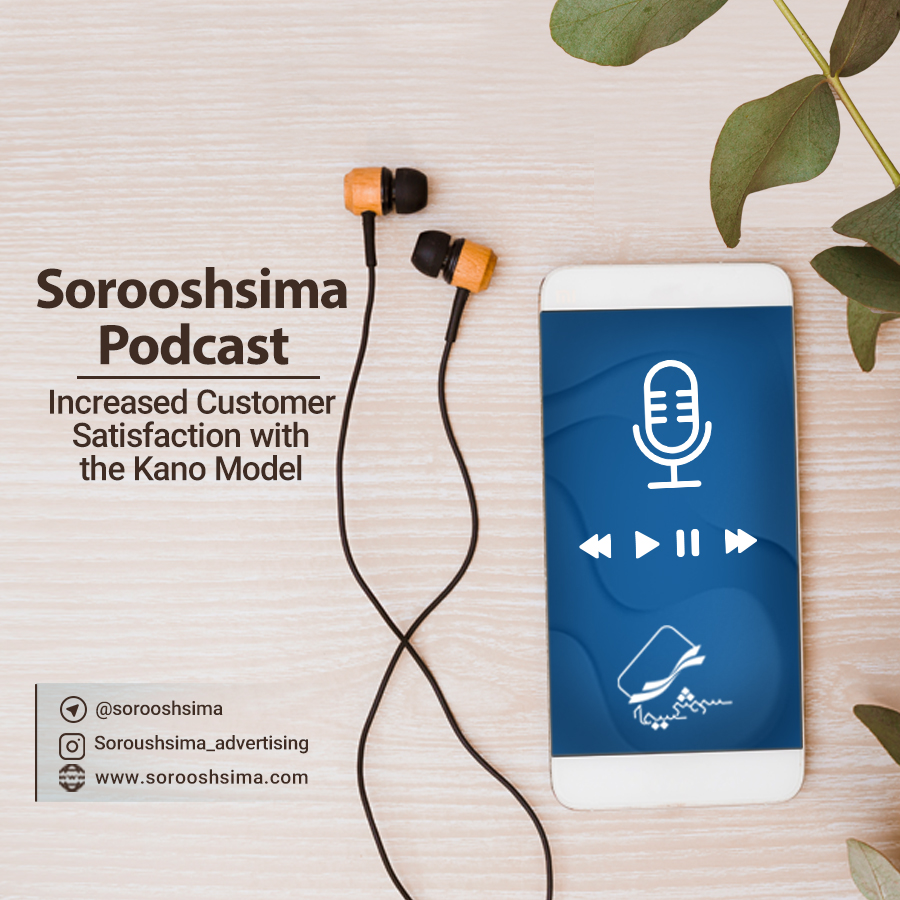Sorooshsima Podcast #20
Increased Customer Satisfaction with the Kano Model

Hi Sorooshsima Podcast Listeners;
It must have happened for you to buy a product because of its glaze and full color ads, and then regret it very much after a few days, because what you had imagined was very different from the product you bought. Now, as a dissatisfied customer, you are not only not going back to that product, but you are also advising others not to be fooled by the advertising and to avoid buying that product.
If you are a business owner, you should always remember that the customer’s satisfaction is everything! And to keep your business, you have to avoid discontent as much as possible.
In this podcast, we want to talk to you about the Kano model to know what features of your product or service depend on customer satisfaction.
The Kano model is derived from the name Noriaki Kano, Rica college professor in Tokyo. This model was introduced late in the 20th century. The Kano model is a customer satisfaction model that is also used with quality function deployment or QFD.
It is usually assumed that customer don’t really know what they want and this has to be said through advertising. But the truth I that customer really know what they want but may not have enough know how to describe that need. By knowing their needs and how to update them, you can better understand your customers’ needs and find the way to deal with them. The Kano Model is very useful for finding a complete understanding of these needs.
Product quality followed by customer satisfaction can be improved with proper management. The Kano model is an efficient tool for measuring the quality of services and products. The Kano Model divides the characteristics of a product into five categories, and in each category, a specific type of need and value is expressed.
Basic features (Must-Be)
Performance features (0ne-Dimensional, or Performance)
Motivational features (Attractive)
Ineffective features (indifferent)
Reverse features (Reverse)
Basic Features
Are related to the basic function of the product. If these needs are not met or their performance is low, it will greatly lead to customer dissatisfaction. A product’s essential features are those that must exist, but are not important to the customer. If these features don’t exist, the product will be unusable and imperfect.
For example, the steering wheel and the wheels are features that are essential in a car, but no customer buys a car because it has a steering wheel.
Functional Features:
The second category of a product features is the functional requirements that if not met, will result in customer dissatisfaction.
For example, the higher the quality of a camera, the more satisfied the customer is, while the poor quality will not be tolerated.
Motivational Features: finally the third category of product features are motivational requirements. This category is key for customer satisfaction. If the needs in this category are properly met or has performs at a high level, creates more satisfaction. If these types of needs are not performed well, will not lead to customer dissatisfaction. Motivational features are neither expected nor demanded by the customers.
For example, suppose you have ordered a watch from an online store, and when you get, it has a beautiful wrapper and since you had not expected this, you will be surprised.
Ineffective Features
Ineffective features are the ones that their type and manner does not matter to the customer. The higher their efficiency and better they are, they have no impact on customer satisfaction.
Reverse Features
These features act reverse, the more they exist, the less customer is satisfied. They are exactly the opposite of functional features.
For example, consider a cellphone, it can be said that it is capable of saving name and numbers of people is a basic need, even though it works without this feature, but it will be difficult.
Performance requirements are often at the heart of competition. When we compare two products and decide what price we are willing to pay for them, we are actually comparing their performance features.
On a cellphone, performance features may be multi-tone rings or video camera quality.
Motivational features are the ones that people don’t really expect, but they satisfy the customer. Even if they only have a few functional features, having a motivational feature may lead to a lot of customer satisfaction.
Suppose a Bluetooth might be a motivational feature on a cellphone for someone.
A key point that the Kano Model pays attention to, is customer needs, therefore as technology evolves, quality levels change over time, increasing competition between manufacturers and delivering new services, that changes the motivational needs to functional needs, then they become basic, or in other words dynamic customer needs and not static ones which should be taken into account when discussing the product and service life cycle.
As such, the Kano Model governs the level of fundamental quality, performance and motivation that are effective in customer satisfaction.
The Kano Model help you understand the customers’ expectations, and when designing and developing new products, take these needs into account. With this model, you can also understand the needs of customers even better the customers themselves, and how different features of a product will create customer satisfaction or dissatisfaction.
Using this model identifies the features that will keep your customer and transform him/her into a loyal customer and find you competitive advantage, look different in the eyes of customers and by eliminating extra features on your time and budget, you could save money.
